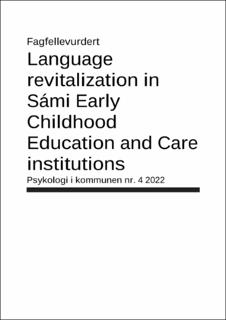Language revitalization in Sámi Early Childhood Education and Care institutions
Peer reviewed, Journal article
Published version
Date
2022-09Metadata
Show full item recordCollections
- Artikler (Articles) [173]
- Publikasjoner fra Cristin - DMMH [138]
Original version
Psykologi i kommunen (PIK). 2022, 4 1-19.Abstract
The aim of this study in seven Sámi Early Childhood Education and Care institutions (ECECs) is to explore how we can understand language revitalization strategies in Sámi ECECs in the light of socio-cultural theories on human learning. The ECEC staff informants point to the important role the Sámi language has in their everyday practice, and to its role in children’s psychosocial development. They highlighted language revitalization in relation to children’s language competence in general, language in play, the staff’s language competence and the language environment in the ECECs. The Sámi ECECs have tried to create an environment for language revitalization based on the children’s participation, social interaction, play, and previous experiences. In some of the ECECs the staff speak less Sámi than some of the children. To stimulate language revitalization, it will be important for the children, according to Vygotsky (1978, p. 86), to communicate with staff who are more proficient in Sámi than they are. To be able to supervise and/or work together with Sámi-speaking ECECs, it is essential that the Educational-Psychological Services (EPS) staff have knowledge of the practices and possibilities for language revitalization. Language revitalization in Sámi Early Childhood Education and Care institutions

